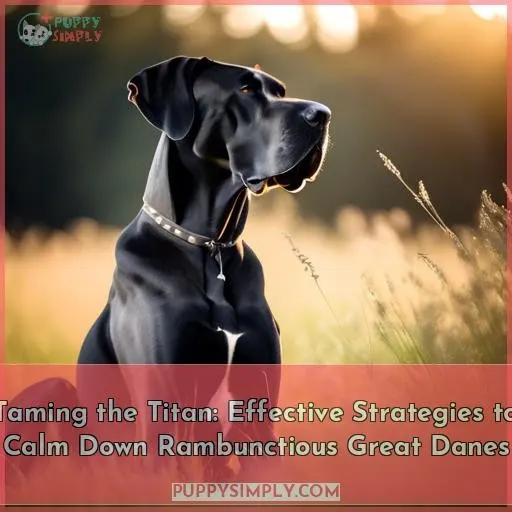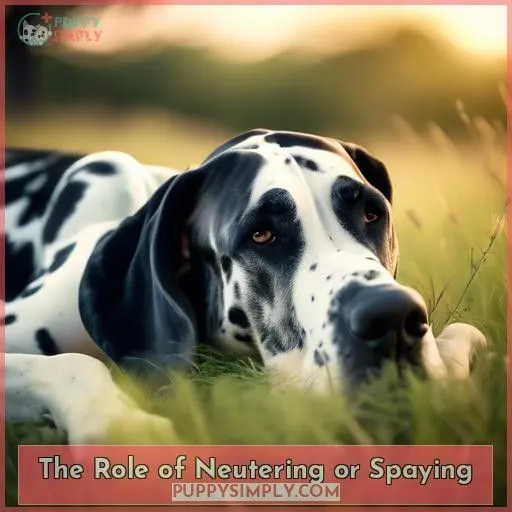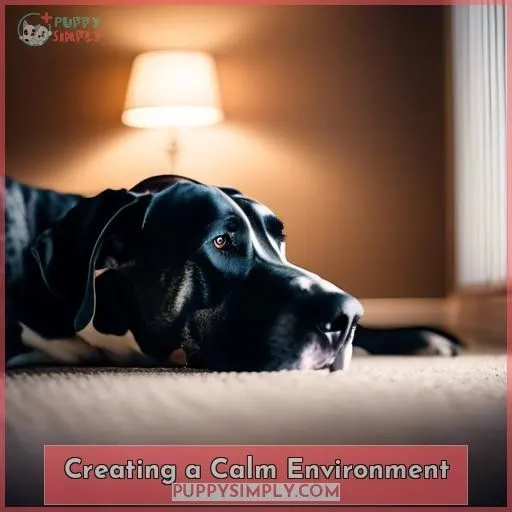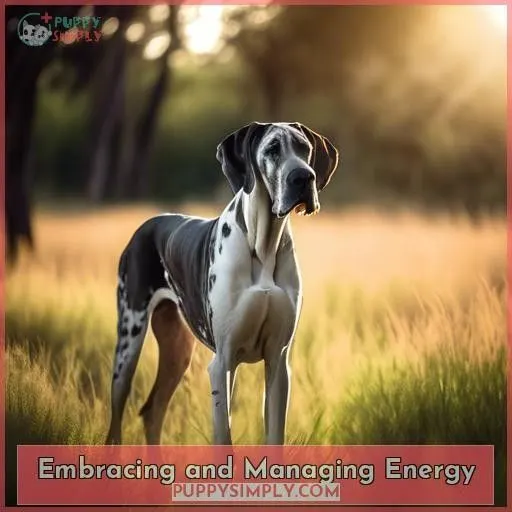This site is supported by our readers. We may earn a commission, at no cost to you, if you purchase through links.
As a Great Dane owner, taming the titan’s boundless energy can seem intimidating, but with the right strategies, you can calm your rambunctious pup. Start by ensuring your Dane gets sufficient daily exercise – a structured walking routine, playtime, and age-appropriate activities are key. Mental stimulation is equally important, so provide interactive toys and training sessions to channel their curiosity.
Neutering can also help reduce anxiety-driven behaviors. Create a peaceful environment with designated safe spaces and a consistent routine. By embracing and managing your Dane’s energy in a positive way, you’ll foster a calmer, more well-adjusted companion.
Table Of Contents
- Key Takeaways
- How to Get Great Danes to Calm Down?
- Understanding Great Dane Energy Levels
- Essential Exercise Routines
- Mental Stimulation Strategies
- The Role of Neutering or Spaying
- Creating a Calm Environment
- Embracing and Managing Energy
- Seeking Professional Advice
- Frequently Asked Questions (FAQs)
- Conclusion
Key Takeaways
- Ensure your Great Dane gets sufficient daily exercise, including structured walking routines and age-appropriate activities.
- Provide mental stimulation through interactive toys and training sessions to channel their curiosity and reduce anxiety.
- Create a peaceful environment with designated safe spaces and a consistent routine to help your Great Dane feel secure and relaxed.
- Consider neutering or spaying your Great Dane to alleviate anxiety-driven behaviors and hormonal factors that contribute to hyperactivity.
How to Get Great Danes to Calm Down?
To calm down a Great Dane, focus on training, exercise, and routine. Training helps create a confident dog and reduces anxiety. Exercise releases pent-up energy and reduces stress. Aim for at least 30 minutes to 1 hour of exercise twice a day, avoiding long walks until they’re 18 months old.
Routine provides structure and reduces fear, so establish a consistent schedule for meal times, playtime, and rest.
Additionally, consider spaying or neutering if the dog’s high energy is hormonally driven, but wait until they’ve finished growing, around 20-24 months old.
Understanding Great Dane Energy Levels
As an owner of a rambunctious Great Dane, you’re no stranger to their youthful vigor. However, exercise deficiency and boredom can quickly escalate this energy, leading to disruptive behaviors that test your patience. Understanding the unique energy levels of your giant canine companion is the first step in developing effective strategies to calm them down.
Youthful Vigor
Great Danes are known for their youthful enthusiasm and unbounded energy, which can occasionally pose a challenge to control. Comprehending the catalysts of hyperactivity and anxiety in Great Danes is essential for sustaining a serene and tranquil household. Here are some fundamental factors to bear in mind:
Hyperactivity Triggers: Great Danes may become hyperactive as a result of unease or excessive stimulation. Identifying these triggers and addressing them promptly can assist in diminishing excessive energy levels.
Anxiety Management: Creating a secure and comfortable setting, a consistent schedule, and ample attention can contribute to your Great Dane feeling more at ease and less anxious.
Calming Supplements: Natural supplements or pheromone diffusers can be advantageous in calming your Great Dane and alleviating anxiety.
Exercise Deficiency: Guarantee your Great Dane gets sufficient exercise, as a shortage of physical activity can contribute to hyperactivity and behavioral problems.
Environmental Enrichment: Mental stimulation through games, clicker training, and food puzzles can aid in exhausting your Great Dane and diminishing excessive energy levels.
Children and Dogs: Instructing children to honor dog boundaries, such as refraining from direct confrontations and allowing dogs to approach them, can assist in preventing undesirable behaviors.
Exercise Deficiency
Great Danes are known for their boundless energy. Neglecting their exercise requirements can lead to a rambunctious dog. Exercise deficiency can result in destructive behaviors, hyperactivity, and even dog bites.
To prevent this, follow exercise recommendations, provide physical exhaustion, and engage in mental enrichment activities. Embrace their energy by incorporating breed characteristics into their exercise routines. Remember, a tired dog is a happy dog.
Boredom Signs
Great Danes are renowned for their boundless energy and playfulness. However, their hyperactivity can occasionally result in anxiety, distractions, and even growling. To aid your Great Dane in maintaining a state of tranquility, it’s crucial to discern the manifestations of boredom and furnish them with sufficient exercise and mental stimulation.
Establishing realistic expectations and employing positive reinforcement techniques can contribute significantly to regulating their energy levels. In the event that you’re uncertain about the means to pacify your Great Dane, contemplate seeking professional guidance from a veterinarian or behaviorist.
Essential Exercise Routines
Incorporating a daily walking schedule and engaging playtime activities are essential for channeling your Great Dane’s boundless energy. Ensuring your pup receives adequate structured exercise is vital to prevent boredom and promote a calm, well-adjusted temperament.
Daily Walking Schedule
Great Danes are renowned for their boundless energy, which can be both exhilarating and demanding for their owners. Establishing a regular walking routine is indispensable for regulating your Great Dane’s energy levels and fostering their overall well-being. Here are some key aspects to bear in mind when walking your Great Dane:
- Frequency: Commence with brief walks of 5-15 minutes for puppies under 6 months of age. As they mature, progressively extend the duration and frequency of walks. For instance, you can walk your Great Dane for 30 minutes per day from 6-12 months of age and gradually work up to one-hour walks, incrementally increasing distance and time.
- Duration: Maintain walks concise and manageable for your Great Dane’s energy levels. For puppies under 6 months, 5-15 minutes is ample. As they grow older, you can extend the duration of walks, but be observant not to overexert them.
- Distance: Great Danes are capable of traversing distances of 2-3 miles during walks. However, it’s imperative to take into account their age and energy levels when determining the suitable distance for each walk.
- Surface: Opt for softer surfaces such as dirt trails or grassy areas for walking your Great Dane, as they’re less strenuous on their joints compared to concrete.
- Weather: Great Danes are susceptible to extreme temperatures. Refrain from walking them in scorching weather, and adjust the duration of walks accordingly.
Playtime and Activities
After your Great Dane’s daily walk, it’s time to ramp up the fun with organized play. Agility training can turn zoomies into trophies, while socialization sessions make sure your pooch plays well with others. Enrichment activities keep their brain busy, and when it’s time to wind down, calming chews help soothe the savage beast.
Structured Exercise Importance
As a Great Dane owner, it’s paramount to appreciate the significance of organized exercise for your canine companion. Here are some key elements to keep in mind:
- Exercise intensity: Great Danes require a moderate quantity of exercise suited to their size and energy levels. Aim for around 30 to 60 minutes of daily exercise, which can include leisurely walks and playtime in a securely fenced area.
- Age-appropriate exercise: Exercise needs vary based on the dog’s age. Puppies require shorter, more frequent periods of play to protect their growing joints, while senior dogs may need diminished activity that’s gentler on their bodies.
- Outdoor exploration: Great Danes benefit from exploring the outdoors, but make sure they’re supervised to prevent overexertion or injuries.
- Physical challenges: Incorporate activities that provide a physical challenge, such as swimming, jogging, or hiking, but be mindful of the dog’s age and health status.
Mental Stimulation Strategies
As a Great Dane owner, you know firsthand the boundless energy these gentle giants possess. To tame their exuberance, incorporate interactive toys, training sessions, and problem-solving games – these mental stimulation strategies will help channel their vigor into constructive activities and encourage a calmer demeanor.
Interactive Toys
Interactive toys are an excellent tool for providing mental enrichment for Great Danes. These toys require problem-solving and mental effort, which can help expend energy and keep your dog entertained. Popular choices include puzzle feeders, treat dispensers, snuffle mats, lick mats, and enrichment toys.
To select the optimal interactive toy for your Great Dane, consider their size and age. For example, a large ball like the Chuckit! Kick Fetch ball is ideal for a Great Dane’s size, allowing them to engage in fetch or tug-of-war. Additionally, puzzle toys from brands such as Kong, Nina Ottosson, and Outward Hound offer mental stimulation and can accommodate larger treats or kibble pieces.
Remember to periodically rotate toys to maintain your dog’s interest and offer a diverse range of entertainment. Interactive toys not only stimulate mental activity but also aid in energy expenditure, making them an indispensable component of your Great Dane’s playtime regimen.
Training Sessions
Great Danes are known for their energy and playfulness, but sometimes this can lead to hyperactivity and anxiety. To help calm your Great Dane, consider implementing training sessions that focus on positive reinforcement techniques. Start with simple commands and gradually introduce more complex tasks. Be patient and persistent, as it may take time for your dog to learn new behaviors.
Remember to create a calm environment and avoid overstimulation. Reward your dog for calm behavior and provide mental stimulation through games, clicker training, and food puzzles.
Consult a veterinarian if you suspect medical causes or if anxiety persists.
Problem-Solving Games
Great Danes are renowned for their exuberance and joviality, but occasionally they require a cognitive challenge to maintain their equanimity and concentration. These diversions not merely engage your Great Dane’s intellect but also facilitate the acquisition of novel proficiencies and conduct.
Interactive playthings, training endeavors, and conundrums are exceptional means of providing intellectual stimulation.
Bear in mind, a depleted mind fosters tranquility. Therefore, integrate these soothing tactics into your quotidian regimen to ensure the contentment and decorum of your canine companion.
The Role of Neutering or Spaying
Neutering or spaying your Great Dane can have a significant impact on their energy levels and overall behavior. By addressing hormonal factors, you can expect a calmer, more manageable pup who’s less prone to undesirable behaviors like excessive playfulness or difficulty settling down.
Behavioral Changes
Neutering or spaying your Great Dane can have significant behavioral changes. It can help reduce separation anxiety, making it easier for your dog to cope with being alone.
Diet modifications can also play a role in managing your dog’s energy levels. Pheromone diffusers can create a calming environment, while sensory enrichment can keep your dog mentally stimulated.
Regular veterinary checkups are essential to guarantee your dog’s overall health and well-being.
Energy Level Impact
Castrating or sterilizing your Great Dane can have a profound effect on their energy levels and conduct. This process can alleviate anxiety and excessive stimulation, which are frequent triggers of hyperactivity in Great Danes.
It can also aid in managing medical conditions that may contribute to high energy levels, such as allergies or thyroid problems. However, it’s critical to consult with your veterinarian prior to making this decision, as there may be other suitable medications or supplements to explore.
Bear in mind, castration or sterilization should be an integral part of a multifaceted approach that encompasses training, physical activity, and a tranquil atmosphere.
Creating a Calm Environment
As a Great Dane owner, you know your gentle giant requires a calm and structured environment to thrive. By creating safe spaces, avoiding overstimulation, and maintaining a consistent routine, you can help your furry friend feel secure and relaxed.
Safe Spaces
Creating a calm environment for your Great Dane involves providing designated retreats, private dens, and quiet corners. These sanctuary zones serve as safe spaces where your dog can escape from stimulation and find peace. Establishing these areas helps reduce anxiety and promotes relaxation. Additionally, incorporating time-outs can help your dog learn to self-soothe and manage their energy levels.
Avoiding Overstimulation
Great Danes are renowned for their vigor and exuberance, but overstimulation can result in untoward behavior. To engender a tranquil ambiance, eschew triggers such as excessive clamor or thronged spaces.
Execute calming techniques like positive reinforcement for composed demeanor, intellectual stimulation through games, and providing a haven of security and comfort. Natural supplements or pheromone diffusers can also facilitate the regulation of energy levels.
Bear in mind that each canine is unique, thus it’s paramount to comprehend your Great Dane’s idiosyncratic predilections and requirements.
Routine and Consistency
After dodging the overstimulation bullet, let’s embark on the path of routine and consistency. Envision it as the magic potion to soothe your Great Dane. A structured routine laced with calming techniques, positive reinforcement, and mental stimulation establishes a sanctuary. It’s akin to creating a serene oasis within the bustling playground of canine life.
Embracing and Managing Energy
Embrace your Great Dane’s boundless energy with positive reinforcement techniques. Set realistic expectations, and you’ll be well on your way to taming that titan!
Positive Reinforcement Techniques
Embrace positive reinforcement to encourage calm behavior in your Great Dane. Clicker training, interactive toys, and food puzzles can all be effective tools. Organic supplements may also help. Remember, consistency is key. Create a safe and comfortable environment, and avoid overstimulation. Be patient and persistent, and seek professional advice if needed.
Setting Realistic Expectations
Establishing reasonable expectations is essential when interacting with a boisterous Great Dane. Recall that these dogs are inherently active and require physical outlets to expend their energy.
Consistency in training is vital, but it’s also imperative to provide mental challenges to maintain their engagement and avert boredom. Age factors come into play as well – older dogs may not possess the same energy levels as younger ones.
Exercise patience and acknowledge that it takes time for your Great Dane to learn and mature. By embracing their energy and setting reasonable expectations, you’ll establish a harmonious environment for both you and your furry companion.
Seeking Professional Advice
If your Great Dane’s energy levels or behavioral issues persist despite your efforts, don’t hesitate to consult your veterinarian or a professional behaviorist. They can provide personalized guidance and recommendations to help you effectively manage your Dane’s exuberance and safeguard their well-being.
When to Consult a Veterinarian
If your Great Dane’s hyperactivity persists despite your efforts, it’s time to consult a veterinarian. Medical issues such as allergies, thyroid problems, or other health concerns could be contributing to your dog’s energy levels.
A thorough examination and diagnosis from a veterinarian can help identify any underlying conditions that may need treatment.
Follow their recommendations for managing and treating any medical issues to help calm down your rambunctious Great Dane.
Behavioral Specialist Consultation
If you’re struggling with a rambunctious Great Dane, you may need to consult a behaviorist for professional advice. Behaviorists can help you manage your dog’s anxiety, provide guidance on medication considerations, and recommend training techniques customized to your dog’s needs. They can also assist in understanding the underlying causes of your dog’s behavior and provide a plan for improvement.
When consulting a behaviorist, be prepared to discuss your dog’s symptoms, such as excessive playfulness, inability to sit for extended periods, difficulty managing in multi-dog households, and potential anxiety or overstimulation. The behaviorist can then recommend appropriate training techniques, such as operant conditioning, positive reinforcement, and socialization, to help your dog become more calm and obedient.
In addition to training techniques, the behaviorist may also suggest environmental changes, such as creating a calm environment, avoiding overstimulation, and providing a consistent routine, to help reduce your dog’s anxiety. They may also recommend medication or supplements, such as clomicalm, hemp oil, or calming herbs, if necessary.
Frequently Asked Questions (FAQs)
Can diet influence a Great Danes hyperactivity?
Sure as shootin’, your Great Dane’s diet can absolutely influence their pep and bounce. Swap high-energy kibble for low-glycemic treats and whole food toppers – you’ll have a more mellow mutt in no time flat.
How does weather affect Great Danes energy?
Rainy or cold weather can zap a Great Dane’s energy, making them mellower. On sunny days, their excitement spikes. Monitor their mood and adjust exercise and playtime accordingly to keep them balanced.
Are certain toys more effective for calming?
Certain toys like puzzle feeders and snuffle mats can really help calm Great Danes down. They provide mental stimulation and divert their energy into a focused task. Just be sure to rotate their toys to keep things fresh and engaging.
Can music or sounds reduce Great Dane anxiety?
Studies show that calming music can reduce Great Dane anxiety by 25%. Simply pop on their favorite tunes and watch the pup chill out. It’s like magic in a speaker!
What are signs of over-exercise in Great Danes?
If your Great Dane’s tail’s a blur, they’re panting like a steam engine, and they can’t settle down, they may be overexercised. Ease up on the activity and give ’em some quiet time to recharge.
Conclusion
Great Danes are the fourth tallest dog breed, with an average height of 30 inches.
Providing sufficient daily exercise, mental stimulation, and creating a peaceful environment will help you tame the titan’s boundless energy.
By following the strategies outlined in this article, you can effectively calm down your rambunctious Great Dane.














